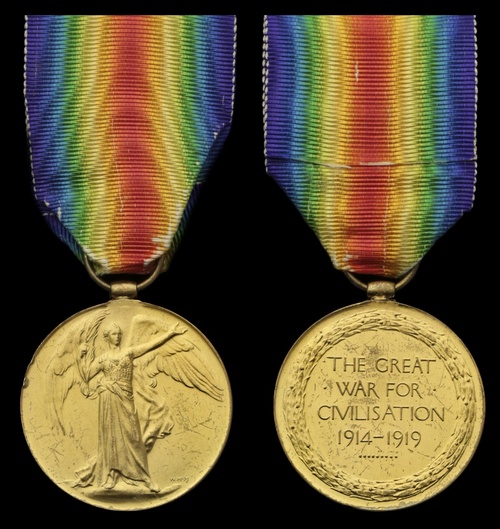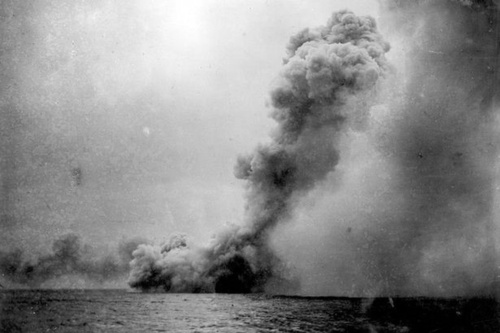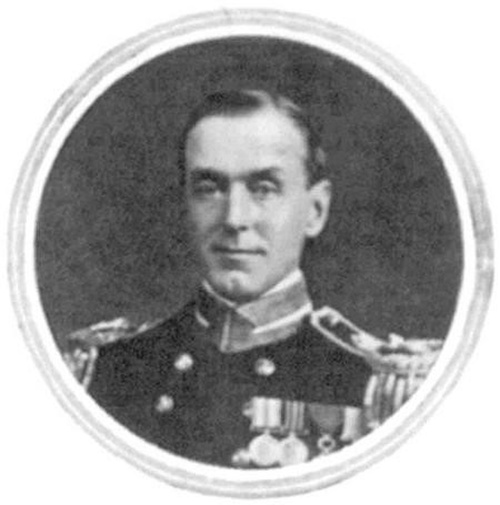Auction: 22003 - Orders, Decorations and Medals
Lot: 158
'The Queen Mary was next ahead of us, and I remember watching her for a little and saw one salvo straddle her. Three shells out of four hit, the impression one got of seeing the splinters fly and the dull red burst was as if no damage was being done, but that the armour was keeping the shells out. The next salvo that I saw straddled her, and two more shells hit her. As they hit I saw a dull red glow amidships and then the ship seemed to open out like a puff ball, or one of those toadstall things when one squeezes it. Then there was another dull red glow somewhere forward and the whole ship seemed to collapse inwards. The funnels and masts fell into the middle, and the hull was blown outwards. The roofs of the turrets were blown 100 feet high, then everything was smoke…
Queen Mary seemed to roll slowly to starboard, her masts and funnels gone, and with a huge hole in her side. She listed again, the hole disappeared beneath the water, which rushed into her and turned her completely over. A minute and a half, and all that could be seen of the Queen Mary was her keel with her propellers still slowly revolving high in the air. In another moment…there was nothing of her left but a dark pillar of smoke rising stem-like till it spread hundreds of feet high (900-1,200 feet) like a vast palm tree … '
Two eye-witness accounts of the final moments of the battle cruiser H.M.S. Queen Mary at Jutland; The Fighting at Jutland, by H. W. Fawcett and G. W. W. Fawcett, refers.
An important Great War Victory Medal awarded to Captain C. I. Prowse, Royal Navy, commanding officer of the ill-fated battle cruiser H.M.S. Queen Mary at Jutland
Having inflicted significant damage on the Derfflinger and Seydlitz, Queen Mary came under telling retaliatory fire from the latter's 12-inch guns - 'it was as if a whirlwind was smashing a forest down' - and one of them caused her forward magazine to explode with devastating consequences:
57 officers and 1,209 men were killed, the greatest death toll for the loss of a single warship in the Great War and the second worst in the history of the Royal Navy, being exceeded only by the loss of the Hood in May 1941
It was this catastrophe which occasioned Beatty's famous observation, "There seems to be something wrong with our bloody ships today"
Victory Medal 1914-19 (Capt. C. I. Prowse, R.N.), extremely fine
Cyril Irby Prowse was born at Clifton, Bristol on 26 September 1866 and entered the Royal Navy as a cadet in January 1880.
He subsequently enjoyed a typical Victorian naval officer's career, gaining steady promotion and witnessing active service, in his case off Egypt in 1880s, in the M'wele operations and at the bombardment of Zanzibar, collecting a 'mention' on the way.
Less typical was the growing list of glowing reports and recommendations on his service record, most of which stated he was well suited for senior command, one such being penned by Admiral of the Fleet John "Jackie" Fisher, G.C.B., O.M., G.C.V.O., a forthright 'man who demanded to be heard, and one who didn't suffer fools lightly.'
The approbation of such senior officers clearly had the desired effect, for in June 1907 Prowse was advanced to Captain and, in October 1914, assumed command of the battle cruiser Queen Mary.
The rest, as they say, is history.
Postscript
Prowse's younger brother, Brigadier-General Charles Bertie Prowse, C.B., D.S.O., was killed a month later on the first day of the Battle of the Somme. He had decided to move his 11th Brigade headquarters into the captured German front line, and while assembling men of the Seaforth Highlanders in the British trenches he was shot in the back by machine-gun fire.
The brothers are remembered on the Prowse window at St. John the Baptist Parish Church, Yeovil, Somerset, and by a memorial tablet at St. Mary Magdalene Church, Taunton, Somerset.
Subject to 20% VAT on Buyer’s Premium. For more information please view Terms and Conditions for Buyers.
Sold for
£400
Starting price
£300









